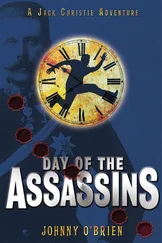Several vehicles throw smoke as they leave the road and try to work around the burning vehicles to their front and rear. Ignoring the sheer magnitude of the masses below, we pick our targets deliberately and engage, hitting them and turning to strike at more.
We continue hitting them, making multiple passes over the column. The pass becomes clogged with smoke from the devastation. Dark plumes rise from each vehicle until the road itself seems on fire. Tracers cease to rise as we fly over.
The last vehicle is hit. The scene below is one of complete destruction. Smoke rolls upward in the chill air with flames visible at times through the dark smoke. Each plume combines with the others until it becomes one continuous line. This pass will be closed for some time to come.
* * *
Picking up speed as they cross the flatland, Trey and his column enter one of the mountain passes that they chased their quarry through the night before. Knowing they are vulnerable in the pass, especially with a gunship to the rear, he notifies the vehicle commanders to maintain their spacing but keep their speed up. So far, according to the satellite footage, which has become spotty in the mountainous terrain, the gunship is still on the ground miles to the south. However, the sooner they can get through, the more relieved he’ll be.
With the end of the pass nearly in sight, he calls for the column to split with half taking another pass to the east, and the other half continuing north. This way, they’ll be harder to hit.
No sooner has he transmitted the words when a blast rocks his vehicle. It rolls to the side and then stabilizes. The next moment, it dives downward as if punched. A concussive explosion rolls through the interior. The instant compression of air within makes him feel like he’s been suddenly submersed in the deep end of a pool. The interior lights blink out momentarily, returning a second later. He knows instantly that he was mistaken about the gunship still being on the ground.
“Driver, floor it!” Trey yells.
He feels his armored vehicle stagger, its momentum stopping suddenly as it is driven heavily downward once again. He barely registers the change as everything goes dark.
* * *
We send several rounds of 40mm along the smoke. Finally, with our dead in the back and feeling a measure of satisfaction that we have exacted a measure of revenge, we bank away from the carnage, turning once again toward the facility coordinates.
Approximately twenty minutes later, the metropolis of Denver becomes visible ahead and to the side, its mass covering a large area. While the population of Denver was only a little over six-hundred thousand people, the outlying urban sprawl brought those numbers to over two and a half million. Those numbers, along with the percentages gleaned from the CDC reports, means that there must be close to a million night runners, at least initially.
Looking at the city as we fly approximately twenty miles away from the outer edges, it’s hard to fathom a million night runners pouring through the streets of the city at night. With those kinds of numbers, I wonder if some haven’t already pushed out of the city as Frank suggested they must do at some point. All of the major cities will have a substantial outflow of night runners as the food supplies within the towns shrink.
As the food supplies diminish, so will the night runner population, and if they push out from the cities, they’ll have to find lairs. That probably means that the smaller townships will see night runners swarm into them. The final population of night runners in any given area will depend upon the food sources. At some point, it will stabilize, with far fewer than there are now. However small that happens to get, it will still far outnumber any remnants of humankind.
The weather will also take its toll. Places like the one we are passing over will more than likely see a drastic reduction in their population as the cold claims lives. I imagine there will be turf wars or the inclusion of smaller packs into larger ones as nature attempts to stabilize itself. Regardless of what the future may be like for them, the important thing is whether we’ll be around long enough for it to matter.
So far, we’ve done okay. We’ve made a lot of mistakes, including the one of sending Greg off on his own, and we will make others, but we’ve made it this far. Tomorrow is another day, but we’re alive today. If only we, humankind, could actually band together against this greater nemesis. We seem to want to do away with ourselves. This fighting between groups doesn’t make sense. It is a form of suicide. There’s no reason why we should be flying over some other group’s base to gather information, with the possibility that we’ll take it out somehow. We should be working together to ensure our mutual survival instead of attacking each other. Yet, here we are, having to do something against our own kind for the sake of our own survival. I just don’t understand it.
The plains below look the same, mile after mile of farmland, the outlines of their rectangles still visible, yet our nav instruments indicate that we are approaching the boundaries of the facility.
“Start the cameras rolling,” I call to Gonzalez.
“Just started them, sir,” she replies.
I watch the landscape below, looking for tracers or tell-tale signs of a missile launch. I’m ready with the counter-measures should the threat receiver light up. So far, though, all indications are that we might as well be flying over Farmer Smith’s aging and rusting tractor.
It doesn’t take us long to pass over. Gonzalez leaves the cameras on for a few moments longer so that we’ll get a look at the surrounding terrain. However, it isn’t long before the third part of our mission has been accomplished. Now we need to land, carry out the subterfuge, and get home. I don’t want to linger in the area, being this close to the supposed facility. It would only take them a little over an hour to get to our location, so we’ll have to make it quick. I don’t expect any trouble seeing we have the Spooky, but they might try to come in fast while we’re on the ground. I would loiter over the area to keep watch, but we just don’t have the fuel for that and Greeley doesn’t carry the type we need. So, it’s fly in, unload, drive to a nearby location, make it look like we’re checking the place out, reload, and take off. Again, with the deep suspicion that the ones who hit Greg are somehow associated with the facility, they won’t be too happy that we made marshmallow cookers out of their armored columns. We can’t give them an open invitation to strike back. In and out.
Having finished with our overflight, and hoping we were able to gather some good information, I begin a descent. I didn’t see anything out of the ordinary and hope the high-definition video will provide some information.
The airport lies to the northeast just outside of the city limits. As we approach, the plains give way to brown crop circles, their shapes still barely visible. Calling Gonzalez to the front to assist, I fly over the city and then the airfield itself.
The town looks like any other we’ve flown over or passed through; mostly residential neighborhoods with brown fields spread throughout. After a couple of passes over the metropolis without seeing any signs of survivors, I turn toward the airport.
I see the outlines of two runways, one north-south, and, just off the southern approach, an east-west one. Two small ramps serve the small fixed-base operations on the field. Surrounding the ramps are the burnt-out remains of hangars. Blackened sheets of steel lie twisted in amongst the wreckage of several aircraft, with everything having been burned to the ground.
Читать дальше












